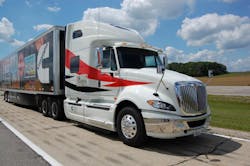COLUMBUS, IN. While the last few years of cheap gasoline and diesel prices have switched many fleets and even some truck manufacturers off to things like alternative fuels and downsized engines, the folks at Cummins, Inc., a company best known as a diesel engine maker, aren't thinking that way at all.
Instead, Cummins is positioning itself more for the long run and broadening its portfolio of products, according to Rich Freeland, the company's president and chief operating officer. That has meant continuing its operations and sales investments in countries like Russia, India, Brazil and China.
On that latter point, China was essentially the initial launching and proving grounds for Cummins' new X12 12L diesel. The engine, company executives said, will offer very significant weight savings vs. a 15L or even 13L diesel without compromising on power. Slated for availability next year and production in Jamestown, NY, the X12 will feature ratings of 350-475 hp and 1250-1700 lbs.-ft. of torque and will target regional haulers, vocational fleets and others where lower weight and optimal efficiency often are key.
Also offering a 12L variant is the ISX 12 G, a compressed natural gas engine produced under the Cummins Westport Inc. joint venture. CNG trucks — though they can offer significant emissions reductions and long-run fuel savings compared with diesel equivalents — almost seem to have dropped off the map in trucking over the last few years, with CNG, at least if purchased at retail rates at fuel stations, actually rising above the cost of diesel.But Cummins, for its part, hasn't slowed its investment in or development of CNG engines, among other technologies. "Markets come and markets go," Freeland told media at a dinner event Monday evening hosted at Miller House and Garden. Now under the care of the Indianapolis Museum of Art, these are hallowed grounds for Cummins: the 60-year-old house belonged to J. Irwin Miller, the general manager and later chairman and CEO who led Cummins to profitability and served the company from 1934 to 1977.
Freeland recalled meeting Miller before coming on as a plant manager, and noted Cummins has come from when "things didn't look so good" in 2000 to the global independent diesel leader it is today — a company Freeland noted now "has cash and no debt." And rather than a one-size-fits-all approach or targeting only one particular power for engines, even when it might not be the hottest buzz in the industry, Freeland said Cummins is betting on the diversity of trucking needs and is ready to offer products for all of them.
Rob Neitzke, president of Cummins Westport, gave the example of waste disposal fleets, which he said match up very well with CNG-powered trucks based on their needs and how they operate. And for fleets that can best use electric power in their trucks — a technology that has gained some momentum in the last year or so — Cummins is planning a powertrain for them as well.
While the company will offer more details and updates Tuesday, that's the message so far: particular businesses' or organizations' operations, with their kaleidoscope of particular duty cycles and needs, will drive highly individualized markets evolving in trucking toward the power and fuel combinations best suited for them.
And Cummins wants to be right there waiting with all the right products to offer when they do.




